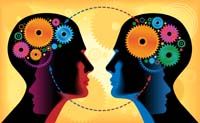

Imagination is a wonderful thing. I love dreaming of trips I’ll make or people I’ll meet. Most of us use imagination in one way or another every day. We imagine what our future might be. We imagine the taste of the new flavor of ice cream that we are about to try. We imagine how we will play with our children. We imagine ourselves thinner or more fit or wiser or kinder. As children we often spend time in imaginary worlds, dreaming that we are riding on spaceships or living in castles or showing off to our friends. Images flood our minds all the time and we get caught up in them.
We also can and often do imagine disasters and get caught up in those images. We see images that are not so pleasant or positive. What will happen if I lose my keys? What will happen if the pipe bursts and everything gets wet? What will happen if I back the car up and hit a post?
Whatever images we see and however much we get caught up in our imaginations, we generally believe that images are simply images, just pictures in our minds. We don’t think that images can make a physical difference to our bodies. But they can.
This is not magical thinking. I am not suggesting that we can open a door by imagining it open. I can dream for hours that the door next to me is open but unless I get up, turn the handle and push, the door will remain closed. I can imagine that I’ll make a trip to the mountains but unless I take transportation to get there, I won’t actually be in the mountains.
We have little influence on doors and mountains, but we can have significant influence on ourselves. Negative images can have a negative effect on us, increasing stress, raising blood pressure, disrupting our digestion. Positive images can have a positive effect, lowering blood pressure, decreasing stress, improving digestion. Guided imagery is already known to benefit health. And now medical research is making us aware of the power of positive motor imagery -- imagining ourselves moving.
If we imagine moving our bodies we experience electrical impulses in our brains and make connections between neurons very much as if we are actually doing what we imagine we are doing. The richer the images the more effective this is. When we imagine movement, we build and strengthen connections in our brain that support movement. Musicians know this. When a musician imagines playing a piece of music before playing it, she can strengthen the abilities she has developed so that when she actually plays her music the movements of her hands will be more precise.
Can imaginary motor images help us heal? Experiences with patients who have lost function in a limb show that imagining movement may, in fact, help reconnect a damaged brain to a limb that is not responding. I am not suggesting that the only thing we need to do is imagine ourselves well. There is no avoiding the hard work of recovery. But deeply feeling and imagining movement can make a positive difference to our ability to heal.

Recently a doctor who specializes in rehabilitation told me about a young woman named Susan who had a stroke. After in-patient treatment Susan’s arm and hand remained unresponsive. Susan did many things to help herself but one of her most intense efforts was imagining movement in her arm and hand every night for a couple of years. She would lie down so her arm was supported and see and feel her arm and hand moving in rhythmic patterns. Susan’s image was of herself standing at a podium conducting an orchestra and she would listen to music while she imagined conducting to make the sense of movement richer and more powerful. One night Susan experienced a sudden flash and opened her eyes to see that her heretofore paralyzed limb was moving in time with the music. She had regained voluntary movement of her arm and hand.
Astonishing but true. We all have the power to influence our bodies. We can, if we chose, add positive motor imagery to the ways we care for ourselves whatever the state of our health. Whether it makes as dramatic a difference as it did for Susan or not, the imagination that we delighted in as children is a tool we can use. We can have fun imagining wonderful things and we can help ourselves in the process.

